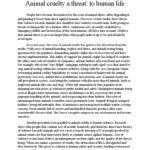In an age where awareness of ethical issues is burgeoning, the narrative surrounding animal cruelty in entertainment often skews towards sensationalism and shock value. While stories of mistreatment and exploitation make headlines, the underlying complexities are frequently neglected. What does the media miss about the phenomenon of animal cruelty in entertainment? The answers are multifaceted, revealing a cultural entanglement of fascination, desensitization, and ethical dilemmas that reflect broader societal values.
First, it is essential to delineate the forms of entertainment that inflict cruelty upon animals. From circuses showcasing exotic animals performing unnatural tricks to movies that employ animal actors under questionable conditions, these manifestations are often romanticized or conveniently glossed over in popular narratives. The juxtaposition of charming visuals against the backdrop of exploitation reveals a disturbing undercurrent—the normalization of violence against animals as a consequence of human entertainment. This raises compelling questions: Why do we, as a society, find solace or joy in such spectacles? What deeper psychological mechanisms govern our fascination with animal suffering?
Many would argue that there exists an evolutionary allure to violence—the primal instinct to witness conflict or struggle is beautifully illustrated in nature itself. Though animal cruelty in entertainment differs vastly from natural predation, the adrenaline-fueled excitement it incites can be captivating. Audiences are drawn to the thrill, often disengaging from the uncomfortable truths hidden beneath the gloss of entertainment. This desensitization is alarming; it has the potential to cultivate a culture that is numb to the suffering of animals, rendering their plight invisible to the very people who consume their representation.
Moreover, there is an inherent hypocrisy in advocating for animal rights while simultaneously consuming media that exploits these beings. Viewers enjoy animal-based entertainment, perhaps unaware of the extensive training, confinement, and, in some cases, brutality these creatures endure. The cognitive dissonance that arises from this duality is noteworthy. Individuals may publicly decry animal cruelty yet partake in the very forms of entertainment that perpetuate it. This disconnect illuminates a significant gap in our moral reasoning and ethical engagement. How can society reconcile such contradictions? This inquiry does not lend itself easily to consensus, revealing the profound complexities of human psychology in relation to empathy.
Media representation is not solely about animal cruelty; it also encompasses anthropomorphism, portraying animals in ways that fit human narratives while often obscuring their reality. When animals are depicted as characters with human-like traits in films or advertisements, the distinction between the animal’s authentic state and their projected persona becomes blurred. Such representations can engender a sense of connection, yet they may also mask the harsh realities of how these animals are treated in entertainment industries. Particularly concerning is the commercialization of animal suffering. The commodification of wildlife can lead to significant ecological consequences, as endangered species are exploited to fulfill the allure of rarity and exoticism for an increasingly desensitized audience. This exploitation not only endangers individual animals but also erodes biodiversity as natural habitats become increasingly compromised.
Furthermore, the media landscape is often indifferent to the systemic forces at play in perpetuating animal cruelty in entertainment. Institutional failures, from inadequate legislation that governs animal welfare to a lack of rigorous enforcement, contribute to an environment in which these injustices can thrive. For instance, regulatory agencies that are supposed to oversee animal welfare in entertainment often operate under constraints that limit their effectiveness. Lack of funding, bureaucratic red tape, and varying standards across jurisdictions can create significant gaps, allowing inhumane treatment to proliferate under the guise of tradition or cultural practices. This systemic neglect begs the question: Are we, as a society, complicit in enabling such cruelty through our consumption patterns and voting decisions?
As consumers of entertainment, we possess a substantial degree of power. Conscious choices influence not only market trends but also societal norms. This is where awareness and activism play pivotal roles. Educating oneself about the realities animals face in the entertainment industry is an essential step—one that can catalyze meaningful change. Viewing entertainment critically, questioning the ethical implications of what we consume, and supporting animal-friendly alternatives are crucial measures in fostering a compassionate society.
Additionally, media literacy and awareness campaigns can illuminate the hidden narratives surrounding animal cruelty. By advocating for transparency and accountability within the entertainment industry, consumers can encourage the demand for humane practices. Such initiatives have the potential to alter perceptions and encourage ethical storytelling that prioritizes the welfare of animals, eschewing sensationalist depictions for narratives grounded in empathy and respect.
In conclusion, the complexities of animal cruelty in entertainment extend far beyond the superficial narratives often presented in mainstream media. The intersections of desensitization, ethical dilemmas, and systemic failures illuminate the need for critical examination of cultural values. Addressing these issues means not just recognizing cruelty but actively engaging in dialogues that transcend sensationalism. Society must confront its fascination with animal suffering and work towards a more humane representation of animals in entertainment—a transformation that begins with informed choices and a commitment to ethical practices.







